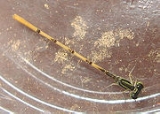
Citrine Forktail
Encyclopedia
The Citrine Forktail, Ischnura hastata, is a damselfly
of the family Coenagrionidae
.
.
Adult males have a black head and thorax, with blue markings, and a largely yellow abdomen, with black markings on its upper surface. The term citrine
refers to its yellowish colouration. Adult females are initially largely orange, marked with black above on the head and rear part of the abdomen. They undergo a colour change, through brown or olive to greyish, as they mature.
Male Citrine Forktails are the only damselflies in the world with the pterostigma
situated away from the leading edge of the wing.
and South America
, although there is also a population on the Azores
. The Azorean population is likely to have been present since the late 19th Century; however, it was not identified as this species until 1990.
, making it the only population of Odonata
anywhere in the world to reproduce by this means — parthenogenesis is unknown in the species' American populations.
In the southern United States, adults are on the wing year-round, while further north the flight-season is from April to November, and in the Azores from May to August.
Damselfly
Damselflies are insects in the order Odonata. Damselflies are similar to dragonflies, but the adults can be distinguished by the fact that the wings of most damselflies are held along, and parallel to, the body when at rest...
of the family Coenagrionidae
Coenagrionidae
The insect family Coenagrionidae is found in the order Odonata and the suborder Zygoptera. The Zygoptera are the damselflies, which although less known than the dragonflies, are no less common. There are more than 1100 species in this family, making it the largest damselfly family...
.
Physical description
This species is 20–27 mm in length, and its hindwing is 11–15 mm long; it is thus considerably smaller than most European members of the genus IschnuraIschnura
Ischnura is a genus of damselflies known as forktails in the family Coenagrionidae. It includes the following species:...
.
Adult males have a black head and thorax, with blue markings, and a largely yellow abdomen, with black markings on its upper surface. The term citrine
Citrine (colour)
Citrine is a colour, derived from coloured varieties of quartz, and variously described as yellow, greenish-yellow, brownish yellow or orange. Actually, as can be ascertained by inspecting its h value, citrine is a medium dark shade of golden yellow...
refers to its yellowish colouration. Adult females are initially largely orange, marked with black above on the head and rear part of the abdomen. They undergo a colour change, through brown or olive to greyish, as they mature.
Male Citrine Forktails are the only damselflies in the world with the pterostigma
Pterostigma
The pterostigma is a cell in the outer wing of insects which is often thickened or coloured and so stands out from other cells. It is particularly noticeable in dragonflies, but present also in other insect groups, such as snakeflies, hymenopterans and megalopterans.The purpose of the pterostigma,...
situated away from the leading edge of the wing.
Distribution
It is native to NorthNorth America
North America is a continent wholly within the Northern Hemisphere and almost wholly within the Western Hemisphere. It is also considered a northern subcontinent of the Americas...
and South America
South America
South America is a continent situated in the Western Hemisphere, mostly in the Southern Hemisphere, with a relatively small portion in the Northern Hemisphere. The continent is also considered a subcontinent of the Americas. It is bordered on the west by the Pacific Ocean and on the north and east...
, although there is also a population on the Azores
Azores
The Archipelago of the Azores is composed of nine volcanic islands situated in the middle of the North Atlantic Ocean, and is located about west from Lisbon and about east from the east coast of North America. The islands, and their economic exclusion zone, form the Autonomous Region of the...
. The Azorean population is likely to have been present since the late 19th Century; however, it was not identified as this species until 1990.
Life history
In North America, this species has a typical dragonfly life-history. However, the population on the Azores reproduces by parthenogenesisParthenogenesis
Parthenogenesis is a form of asexual reproduction found in females, where growth and development of embryos occur without fertilization by a male...
, making it the only population of Odonata
Odonata
Odonata is an order of insects, encompassing dragonflies and damselflies . The word dragonfly is also sometimes used to refer to all Odonata, but the back-formation odonate is a more correct English name for the group as a whole...
anywhere in the world to reproduce by this means — parthenogenesis is unknown in the species' American populations.
In the southern United States, adults are on the wing year-round, while further north the flight-season is from April to November, and in the Azores from May to August.

